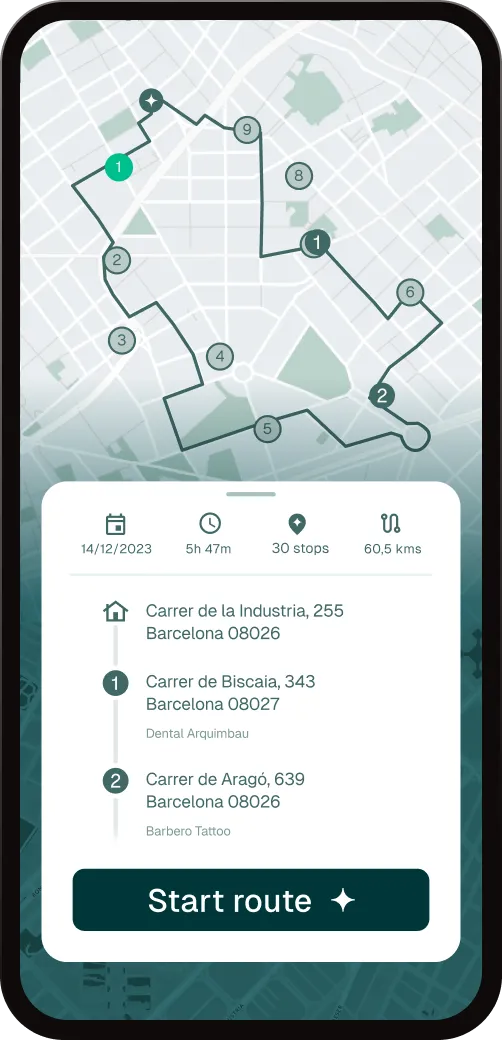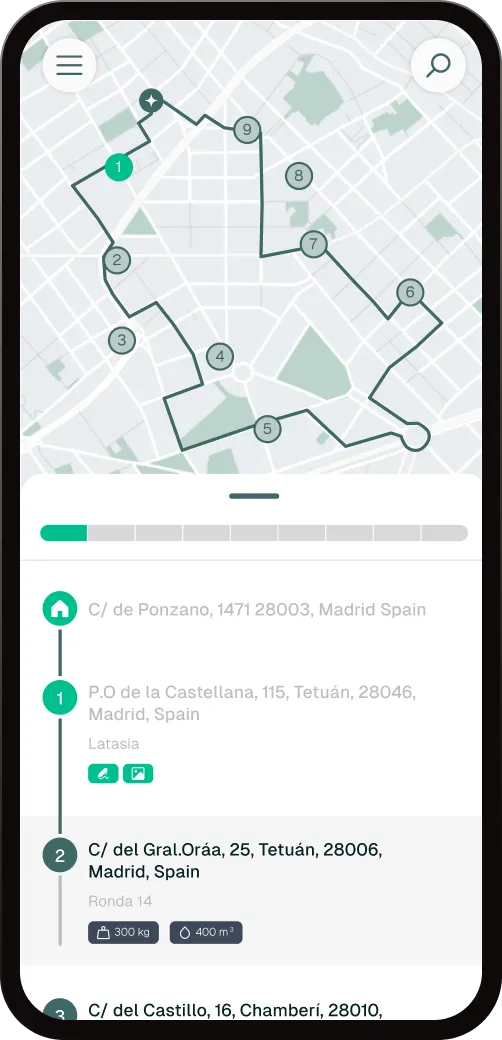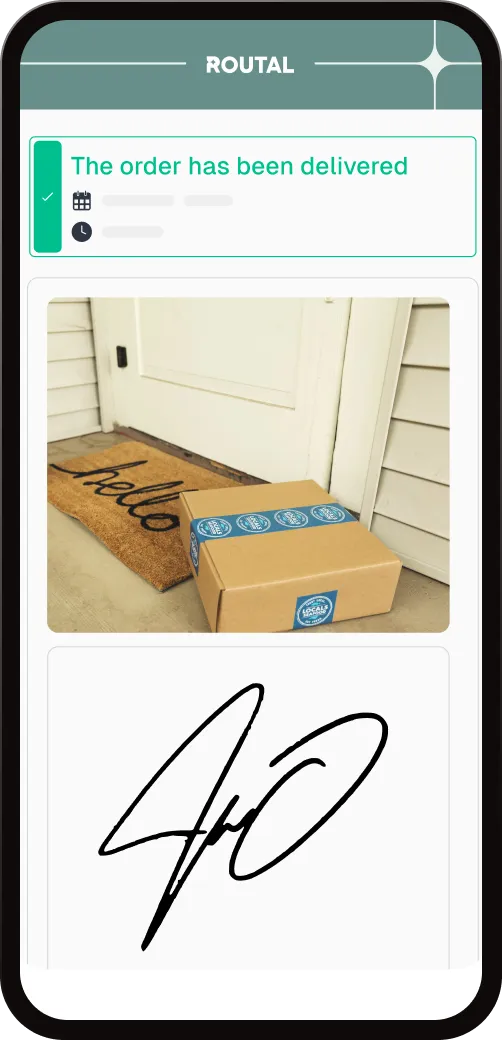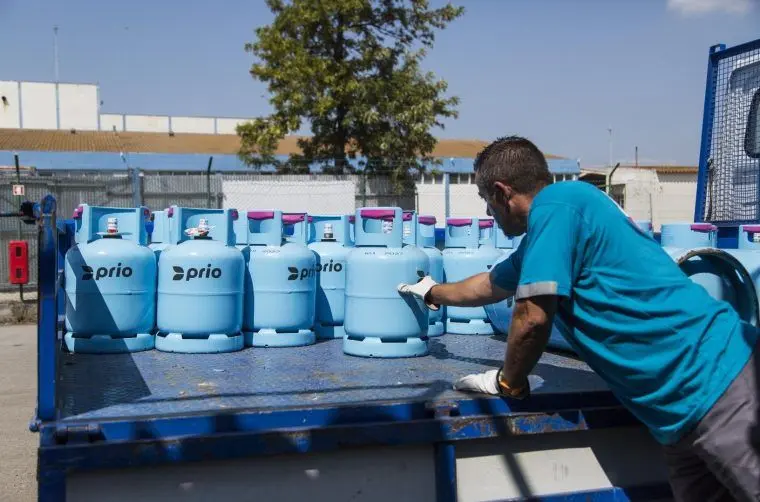Planifica mejor tus rutas en México

Plan and optimize your routes in seconds.
tus rutas en segundos





















Automate all your last-mile processes
You'll have all the parameters you need to give you the best results instantly.
Finally a simple planner that you can use today.

The drivers they only need a cell phone and internet access.

Raise the customer experience.
Precise updates.


We help large and small companies in . Thank you!














Optimize your routes in 3 clicks
Success stories, transformative results.
Our latest news and industry know-how.
%20(22).webp)
In core markets—where competition is fierce, margins are tight and punctuality is everything— having a well-oiled logistics operation is no longer a competitive advantage. It's a necessity.
In this article, we'll tell you why efficient route planning, together with the standardization of distribution processes, can make a difference for your business. Especially if you operate in areas of high density and demand such as wholesale markets, urban distribution centers or industrial areas.
1. Maximizes operational efficiency (and reduces costs)
With good route planning, you can significantly reduce kilometers traveled, fuel consumption and road time. Not only does this lower costs, it also improves the lifespan of your fleet and reduces stress on the delivery team.
The standardization of processes helps each order to be managed in the same way, reducing errors and improvisations and wasted time in daily operations.
2. Faster and more accurate delivery
When each route is optimized and each step of the distribution process is clearly defined, delivery times are shortened and customers receive exactly what they expect. Deliveries in a timely manner.
This is essential in core markets where customers expect agile logistics, with very tight time windows, because their business, mainly hospitality, depends on it.
3. Greater control and visibility in real time
Technology such as Routal allows for minute-by-minute monitoring of each delivery. An urgent order? A customer who changes address at the last minute? With full visibility, you can react in time.
In addition, having standardized processes makes it easier to analyze key metrics: delivery time, route efficiency, level of customer satisfaction, etc.
4. Better customer experience (and greater loyalty)
Efficient logistics can't just be seen in the numbers, it's also felt in the experience. Customers who receive their products on time, informed and with the option to give feedback, are happier... and more loyal customers.
Our studies show an increase of almost 20% in retention a few months after implementing the solution. We have even been able to see comments from satisfied customers due to the improved level of service.
5. Scalability without chaos
When you standardize your processes and use planning tools like Routal, scaling your operation—more zones, more vehicles, more customers—is much easier. Everything is supported by a system that already works.
The balance lies in defining a single way of working and letting experience make those small quality decisions that make them essential in their position. But that without them, the company can continue to operate efficiently.
In short: Efficiency and consistency, the secret of winners
Whether you operate in central markets, or in any type of capillary distribution operation, you cannot leave logistics to chance, not even in the hands of a single person.
The combination of well-planned routes and well-defined processes allows you to operate efficiently, provide better service and grow while maintaining a predictable level of service.
Do you want to see how Routal can help you transform your distribution? Request a demo and start optimizing your operation today.
%20(12).webp)
At Routal we are very proud to announce that we have been awarded the award Top Performer Fall 2025 Of SourceForge , the world's largest B2B software review and comparison platform, attracting nearly 20 million software buyers every month.
This recognition highlights products with a high volume of recent and excellent user reviews, placing them in the top 10% of the best rated products from among more than 100,000 tools evaluated on the platform.
“We're excited to announce the exceptional Top Performers of this fall of 2025,” says Logan Abbott, president of SourceForge. “Routal has proven to be highly valued by its users, as reflected in the large number of outstanding reviews it has received.”
This award is even more special for us because We have already been recognized as Top Performers for eight consecutive quarters. Eight times in a row on the podium. Eight quarters in which our users have confirmed, with their feedback, that we are on the right track.
“At Routal, we are thrilled to receive this recognition from SourceForge once again. We work every day to provide a robust, intuitive and powerful platform that makes it easy to plan, optimize and track last-mile deliveries. That our users rate it with so many positive reviews is the best reward,” says our management team.
This award belongs to all of you: our users, who use Routal to design efficient routes, improve delivery times and provide a memorable customer experience.
Thank you for trusting Routal! We continue to work to offer the best in every delivery.
%20(11).webp)
In recent years, artificial intelligence has taken gigantic strides and tools such as ChatGPT have become increasingly popular. It's common for many companies to ask themselves:
”Can I use ChatGPT to solve my logistics and route planning problems?” The short answer is: Not at all. And in this article, we explain why.
What is ChatGPT and what is it for?
ChatGPT is a language model trained to understand and generate text in a coherent way. It's ideal for tasks such as:
- Compose automated emails or messages.
- Respond to customer inquiries in natural language.
- Help understand complex documentation.
- Identify conversational or behavioral patterns.
In short, ChatGPT shines in unstructured processes or contexts where human language is key. But that doesn't mean it's the right tool for solve a mathematical route optimization problem.
What is route optimization and what does it require?
Route optimization is a highly structured process that involves complex calculations to determine the most efficient path for making multiple deliveries or visits. It takes into account variables such as:
- Traffic and estimated times.
- Vehicle capacities.
- Delivery time windows.
- Operating costs and service priorities
Solving this type of problem requires specialized algorithms that belong to another field of artificial intelligence: Operational research or mathematical optimization.
Tools like Routal use optimization engines specifically designed to plan routes efficiently, something that an LLM like ChatGPT is not prepared to do.
Where can an LLM such as ChatGPT provide value?
Although you can't decide which is the best route for a delivery, ChatGPT can bring a lot of value to the logistics chain. For example:
- Personalized communication with the customer: Generate proactive messages about the status of the order, answer frequent questions or send automated satisfaction surveys.
- Understanding the business context: ChatGPT is very useful for understanding the problem faced by a distribution company and helping to translate it into a technical need.
- Conversational analysis: Detect patterns in customer complaints or understand which areas generate the most friction.
At Routal, for example, we use ChatGPT to improve our interaction with users and to understand more precisely the challenges they face. This allows us to offer solutions that are more aligned with your real needs.
Optimization and language: two complementary pillars
Both LLMs and optimization engines They are part of the big artificial intelligence family, but they are designed to solve very different types of problems:
Optimization engines: Solve structured problems such as planning routes, minimizing costs and organizing resources.
Language Models (LLM): Understand natural language, assist in decision-making, facilitate interaction with people.
Combining both technologies is where the real magic lies.
Try it yourself
At Routal we have integrated processes that take advantage of the power of ChatGPT to better understand the objectives of our clients and, from there, use our optimization engines to design efficient and sustainable routes.
If you are a mass-market company or you have hair and last mile processes, we encourage you to try out how artificial intelligence can help you: reduce delivery times, improve customer experience and optimize your costs.
Technology is here to help, but choosing the right tool for each task is what really makes the difference.










.webp)






















.png)
